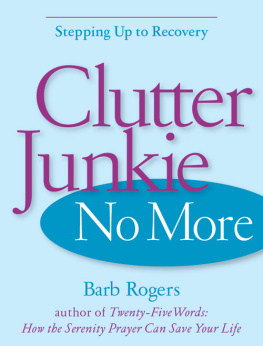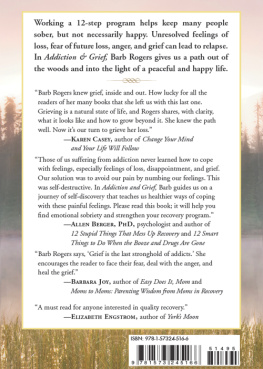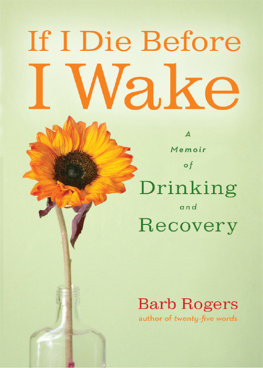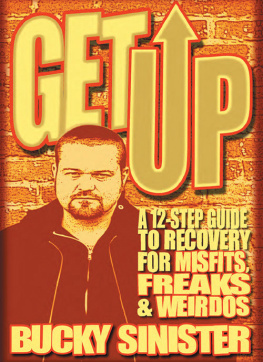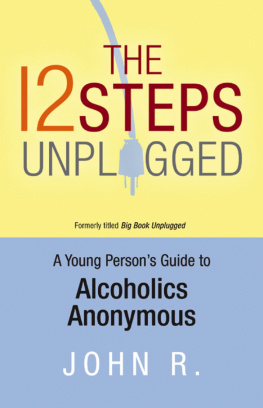Praise for Barb Rogers and her other books:
Keep It Simple & Sane is a simple, heartfelt, refreshingly honest look at how to keep life simple and meaningful. A book that will benefit everyone who reads it.
ELIZABETH ENGSTROM, author of The Northwoods Chronicles
Barb Rogers offers help, peace, and encouragement to those ready to change their lives for the good.
THOMAS BIEN, PH.D., author of Mindful Recovery: A Spiritual Path to Healing from Addiction
Extremely helpful for anyone who is trying to find a way to deal with stinking thinking and establish a healthier balance in life. Keep It Simple & Sane definitely deserves a spot your bookshelf.
ALLEN BERGER, PH.D., psychologist and author of 12 Stupid Things That Mess Up Recovery
Barb Rogers weaves her tragic story of addiction and miraculous recovery within the tapestry of thoughtful and sensible suggestions for discovering and maintaining a lifetime of peace. She is a wonderful example of what the promises tell us await us.
KAREN CASEY, PH.D., author of Codependence and the Power of Detachment

First published in 2009 by
Red Wheel/Weiser, LLC
With offices at:
500 Third Street, Suite 230
San Francisco, CA 94107
www.redwheelweiser.com
Copyright 2009 by Barb Rogers
All rights reserved. No part of this publication may be reproduced or transmitted in any form or by any means, electronic or mechanical, including photocopying, recording, or by any information storage and retrieval system, without permission in writing from Red Wheel/Weiser, LLC. Reviewers may quote brief passages.
ISBN: 978-1-57324-422-0
LIBRARY OF CONGRESS CATALOGING-IN-PUBLICATION DATA
Rogers, Barb, 1947
12 steps that can save your life : real-life stories from people who are walking the walk / Barb Rogers.
p. cm.
ISBN 978-1-57324-422-0 (alk. paper)
1. Substance abuseTreatment. 2. AddictsRehabilitation. 3. Twelve-step programs. I. Title. II. Title: Twelve steps that can save your life.
HV4998.R64 2009
616.86'060922dc22
2009005690
Cover and text design by Maxine Ressler
Typeset in Bembo Std, Impressum, and NeutraText
Cover photographiStockphoto.com/Agnes Csondor
Printed in Canada
TCP
10 9 8 7 6 5 4 3 2 1
www.redwheelweiser.com
www.redwheelweiser.com/newsletter
Contents
Introduction
George P., an auto mechanic from Illinois, says, I am an alcoholic. I will be an alcoholic until the day I die. And if I don't keep something between me and the bottle, I will drink again. George's addiction is alcohol, but that statement can apply to any addiction. It is simply human nature to attempt to fill a hole left in us by one thing with something else. Otherwise, we run the danger of returning to what was familiar.
Imagine that you have been living in the same space for years. All your furniture is in place, right where you want it. It's a comfortable place. Suddenly, your couch disappears. From that moment on, every time you walk into that room your attention is drawn to the empty space previously occupied by the couch. Until you find something to replace it, there will be a feeling of something missing in your life. Isn't that where addiction begins?
In my more than twenty-five years in recovery from my own addictions, listening to the stories of others, I've discovered some common threads that weave us together no matter the addiction. The most common thread is that something is missing. Like the couch, it's the only thing on which we can focus. We find something to fill the hole in our lives. It works for a while, and then it becomes an addiction that takes over our lives. It never works for long, because we can't replace a couch with a table. A couch and a table serve two entirely different purposes.
What is missing in your life? Is it love, acceptance, self-esteem, self-respect, the respect of others, unfulfilled expectations of what you imagined your life should be, or perhaps control? What are you using to replace the missing part of you? Does it work? You will know whether something is working because you will know what it is to live a contented, happy life. How's it going? Are you content, or confused? Are you happy, or frustrated? Are you at peace, or full of fear? Do you look forward to the day ahead, or do you dread it?
12 Steps: Cult, Curse, or Cure?
Many thoughts, ideas, concepts, and even studies have been focused on overcoming addiction, but by far the most widely used and most successful solution for over seventy years has been a 12-step program that originated with Bill W. and Dr. Bob, for those suffering from alcoholism. What is it about the 12-step program, used today for every imaginable addiction, that has successfully changed the lives of those seemingly helpless, hopeless addicts?
Is it a cult? To qualify as a cult, a movement must have a leader, or an overreaching concept, by which everyone involved is ruled. There is no guru, president, board, or religious leader running any 12-step program. Every participant is as important as the next and is entitled to her own beliefs and opinions. There are no rulesonly twelve suggested steps. It is entirely up to each individual if, when, and how he chooses to incorporate any, or all, of the steps into his life. What's the cost? There are no fees, initiations, hazing, or rejection. If a person believes she belongs in a meeting, she does, and if she's strapped, with no money to put into the basket, it doesn't matter. The only requirement is a desire to find a better way of life, free of addiction. It doesn't even have to be an honest desire.
Is it a curse? Many who return to a 12-step meeting after a relapse say, There's nothing worse than a belly full of booze and a head full of AA (referring to the original 12-step program, Alcoholics Anonymous). Once they have discovered a solution, those who continue on with their addiction, whatever it might be, know the curse of conflict. Through the period of addiction, the addict may convince himself there's no way out, but once the addict has been introduced to a 12-step meeting, and to others who have overcome the same addiction and come out on the other side, there is no more justification for continuing in the addiction.
Someparticularly those around the addictmay consider a 12-step program as a curse. During the process of working the steps, the addict will go through many profound changes. For those who have been active participants, codependents, or caretakers, the changes may not be welcome: There is comfort in predictability. Therefore, what happens when the recovering addict begins to think differentlyto act, and react, in an unpredictable way?
Active participants may attempt to lure the person back into addiction. It's not that they don't care about the person as much as they can; it's that, above all things, they must protect their rationalization to continue in their own addiction. They will say things like:
You could have just one drink. One won't hurt you.
Have you put on weight?
It's just a penny game of cards. Surely that won't hurt you.
You can go back on your diet tomorrow.
Your house doesn't look that bad. You can clean it later.
If you pay your car payment late, you can buy this. It's on sale now, and you really need it.
A little pot won't hurt you.
It was prescribed by a doctor. He wouldn't give you something addictive.
The codependent might feel perturbed because she tells herself she's been trying to help for years and now the addict is listening to complete strangers, people who can't possibly care as much as she. The truth is that codependents feel as if they are losing somethingcontrol over an active addict, an excuse to continue their own questionable behavior, the ability to martyr themselves before the world. There will simply be no more statements like Poor Mary. She's put up with so much for so long or Jim must be a saint. I don't know how he deals with her. Addicts who choose recovery make a decision, and codependents are thrust into that decision.


